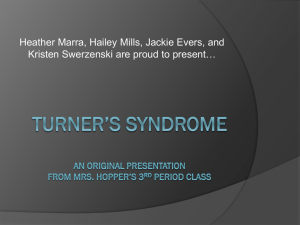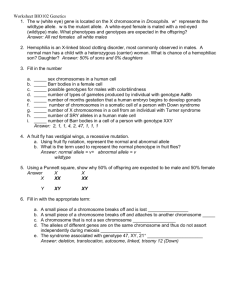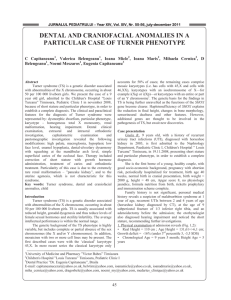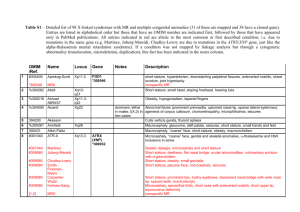mosaicism 78. xx/77, xo in a bull
advertisement
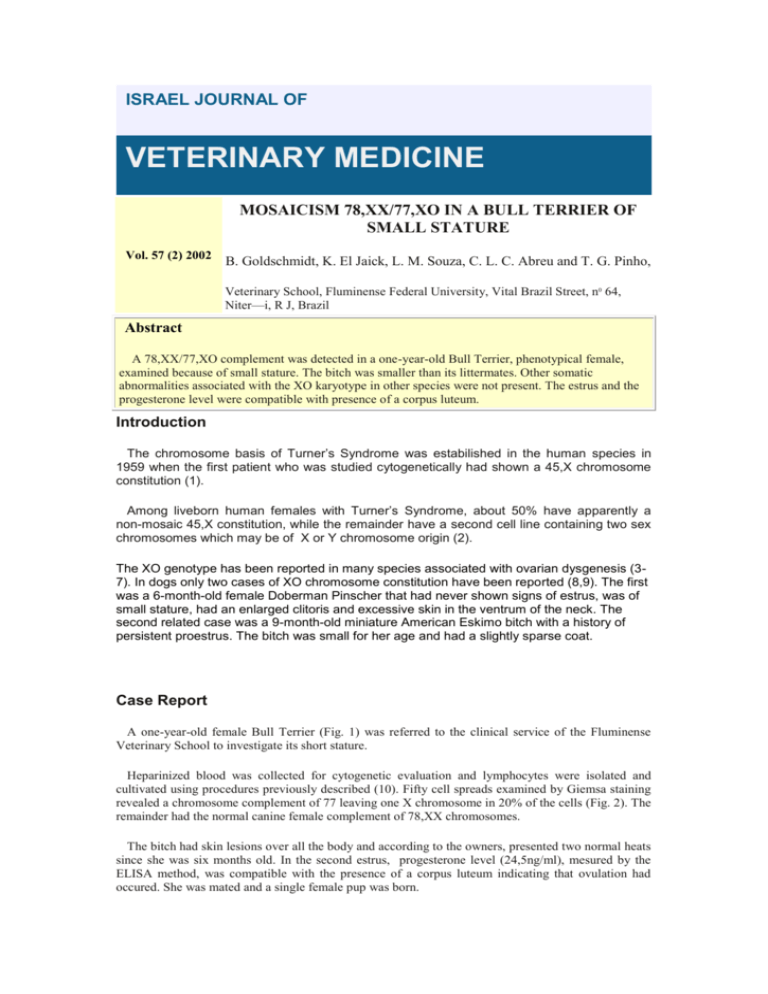
ISRAEL JOURNAL OF VETERINARY MEDICINE MOSAICISM 78,XX/77,XO IN A BULL TERRIER OF SMALL STATURE Vol. 57 (2) 2002 B. Goldschmidt, K. El Jaick, L. M. Souza, C. L. C. Abreu and T. G. Pinho, Veterinary School, Fluminense Federal University, Vital Brazil Street, n0 64, Niter—i, R J, Brazil Abstract A 78,XX/77,XO complement was detected in a one-year-old Bull Terrier, phenotypical female, examined because of small stature. The bitch was smaller than its littermates. Other somatic abnormalities associated with the XO karyotype in other species were not present. The estrus and the progesterone level were compatible with presence of a corpus luteum. Introduction The chromosome basis of Turner’s Syndrome was estabilished in the human species in 1959 when the first patient who was studied cytogenetically had shown a 45,X chromosome constitution (1). Among liveborn human females with Turner’s Syndrome, about 50% have apparently a non-mosaic 45,X constitution, while the remainder have a second cell line containing two sex chromosomes which may be of X or Y chromosome origin (2). The XO genotype has been reported in many species associated with ovarian dysgenesis (37). In dogs only two cases of XO chromosome constitution have been reported (8,9). The first was a 6-month-old female Doberman Pinscher that had never shown signs of estrus, was of small stature, had an enlarged clitoris and excessive skin in the ventrum of the neck. The second related case was a 9-month-old miniature American Eskimo bitch with a history of persistent proestrus. The bitch was small for her age and had a slightly sparse coat. Case Report A one-year-old female Bull Terrier (Fig. 1) was referred to the clinical service of the Fluminense Veterinary School to investigate its short stature. Heparinized blood was collected for cytogenetic evaluation and lymphocytes were isolated and cultivated using procedures previously described (10). Fifty cell spreads examined by Giemsa staining revealed a chromosome complement of 77 leaving one X chromosome in 20% of the cells (Fig. 2). The remainder had the normal canine female complement of 78,XX chromosomes. The bitch had skin lesions over all the body and according to the owners, presented two normal heats since she was six months old. In the second estrus, progesterone level (24,5ng/ml), mesured by the ELISA method, was compatible with the presence of a corpus luteum indicating that ovulation had occured. She was mated and a single female pup was born. Figure 2 - A metaphase showing monosomy of X chromo Figure 1 - Female bull terrier with small stature Discussion Our case represents mosaicism of post-zygotic mitotic origin, where a Turner line originated from a normal XX karyotype. The short stature in this dog could be attributed to the XO genotype, since small stature and hypoplasia of the genital system is commonly reported in animals of other species with monosomy-X. The progesterone level (24,5 ng/ml) and the birth of only one pup suggest that in this level of mosaicism the gonads were not completely dysgenetic. The phenotypic manifestations of X monosomy in human females are due to the absence of the short arm. The terminal Xp deletions have somatic trait characteristics of the Turner Syndrome, with short stature whereas function is generally preserved. On other hand, more extensive Xp deletions lengthening to the proximal region of Xp11 are associated in most cases with a complete Turner Syndrome phenotype, including gonadal dysgenesis (11). The proportion of detectable mosaicism is much lower among spontaneous abortions than livebirths with a XO cell line (12) and it has been suggested that the non-mosaic XO constitution is a pre-natal lethal condition and that liveborn individuals with Turner’s Syndrome have a second cell line, whether or not it is demonstrable by conventional cytogenetic techniques (13). X monosomy in dogs is an extremely rare chromosome aberration. As far as we know, very few cases have been reported and none of them consisted of mosaicism (8,9). This bitch had a short stature and low fertility in common with other mammals with an XO karyotype. References 1. Ford, C. E., Jones, K. W., Polani, P. E., De Almeida, J. C. And Briggs. J.H.: A Sex chromosome anomaly in a case of gonadal dysgenesis (Turner’s Syndrome). Lancet i, 711-713, 1959 2. Magenis, R. E., Breg, W. R., Clark, K. A., Hook, E. B., Palmer, C. G., Pasztor, L. M., Summitt, R. L. and Van Dyke, D.: Distribution of Sex chromosome complements in 651 patients with Turner’s Syndrome. Am. J. Hum. Genet. 32: 79A, 1980. 3. Sharma, T. And Raman, R.: An XO female in the Indian mole rat. J. Hered. 62: 384-387, 1971. 4. Weiss, G., Weick, R .F., Knobil, E., Wolman, S. R. And Gorstein, F.: An XO anomaly and ovarian dysgenesis in a Rhesus monkey. Folia Primatol (Basel) 19: 24-27, 1973. 5. Chandley, A. C., Fletcher, J., Rossdale, P.D., Peace, C. K., Ricketts, S. W., MaEnery, R. M., thorne, J. O., Short, R. V. And Allen, W. R.: Chromosome abnormalities as a cause of infertility in mares. J. Reprod. Fertil. (Suppl) 23: 337-383, 1975. 6. Long, S. E. and Berepubo, N. A.: A 37 XO chromosome complement in a kitten. J. Small Anim. Pract. 21: 627-631, 1980. 7. Zartman, D. L., Hinesley, L. L. and Gnalkowski, M. W.: A 53X female sheep (Ovis aires). Cytogenet. Cell Genet. 30: 54-58, 1981. 8. Smith, F. W., Bouen, L. C., Weber, A. F., Johnston, S. D., Randolph, J. F. and Waters, D.J.: Xchromosomal monosomy (77,XO) in a Doberman Pinscher with gonadal dysgenesis. J. Vet. Intern. Med. 3: 90-95, 1989. 9. Lšfstedt, R. M., Buoen, L. C., Weber, A. F., Johnston, S. D., Huntington, A. and Concannon, P. W.: Prolonged proestrus in a bitch with X chromosomal monosomy (77,XO). J. Am. Vet. Med. Assoc. 200(8): 1104-1106, 1992. 10. Moorhead, P. S., Nowell, P. C., Nellman, W. J., Battips, D. M. and Hungerford, D. A.: Chromosome preparations of leucocytes cultures from human peripheral blood. Exp. Cell Res. 20: 613-616, 1960. 11. Jacobs, P. A., Betts, P. R., Cockwell, A. E., Crolla, J. A., MacKenzie, M. J., Robinson, D. O. And Youings, S. A.: A cytogenetic and molecular reappraisal of a series of patients with Turner’s Syndrome. Ann. Hum. Genet.54: 209-223, 1990. 12. Hassold, T., Benham, F. and Leppert, M.: Cytogenetic and molecular analysis of Sexchromosomes monosomy. Am. J. Hum. Genet. 42: 534-541, 1988. 13. Hook, E. B. and Warburton, D.: The distribution of chromosomal genotypes associated with Turner’s syndrome: livebirth prevalence rates and evidence for diminished fetal mortality and severity in genotypes associated with sructural X abnormalities or mosaicism. Hum. Genet. 64: 24-27, 1983.
